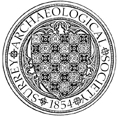Watching brief at 46 Downing Street, 1996
A watching brief by K D Graham of SyAS on the works for a rear extension revealed no features or finds of archaeological interest apart from a carved stone block with the initials of James Newland Baker who was responsible for constructing the walls in the 19th century.



